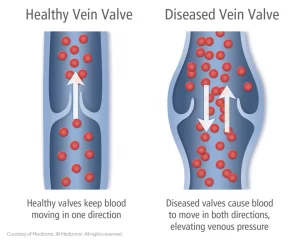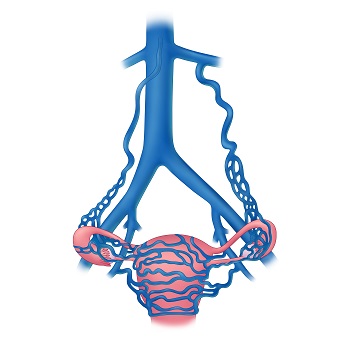Ovarian Vein Reflux Therapy | Treating Pelvic Venous Congestion | Pelvic Varicose Veins
What is Ovarian Vein Reflux?
 Ovarian vein reflux is a condition in which valves located within the ovarian veins of women become dysfunctional. This condition is typically associated with the development of abnormal varicose veins within the pelvis. The other term often used for the condition is Pelvic Congestion Syndrome. The condition more often occurs in women who have been pregnant and even more so in women who have had multiple pregnancies. It is felt that many different factors may contribute to the development of this condition, including weak vein valves, pelvic vein trauma, elevated uterine and pelvic vein flow, clots and inflammation within the veins, and fluctuations of female hormone levels. It is believed that the majority of women with ovarian vein reflux develop chronic pelvic pain.
Ovarian vein reflux is a condition in which valves located within the ovarian veins of women become dysfunctional. This condition is typically associated with the development of abnormal varicose veins within the pelvis. The other term often used for the condition is Pelvic Congestion Syndrome. The condition more often occurs in women who have been pregnant and even more so in women who have had multiple pregnancies. It is felt that many different factors may contribute to the development of this condition, including weak vein valves, pelvic vein trauma, elevated uterine and pelvic vein flow, clots and inflammation within the veins, and fluctuations of female hormone levels. It is believed that the majority of women with ovarian vein reflux develop chronic pelvic pain.
What Are Ovarian Veins?
Every woman has 2 ovarian veins, one on each side of the body. Each ovarian vein drains the deoxygenated venous blood from the region of the corresponding ovary in the pelvis up into the abdominal area. Once the veins reach the upper abdomen, these veins then dump their blood into larger veins, either the renal vein (kidney vein) or the vena cava (the largest vein in the body). The direction of the blood is propelled upward towards the heart through the function of many vein valves within the lumen of the ovarian veins. The return of venous blood from the pelvis up towards the heart allow the oxygen deprived blood within the veins to work its way up to the heart and lungs in order to get replenished with oxygen once again.
What Are The Affects of Having Ovarian Vein Reflux ?
When women acquire ovarian vein reflux, it occurs due to the failure of the vein valves within the ovarian vein. When vein valves are unable to propel blood upwards it will have a tendency to “reflux” backwards. The vein blood then reverses direction and travels back down the vein towards the pelvis and ovaries. This is purely the result of gravity affect. This is detrimental to the health of the body since it leads to “pooling” of deoxygenated blood within the pelvis as well as abnormal pressure build-up within the pelvic veins. If it occurs on the left side of the body it typically leads to chronic left pelvic pain (and vice versa if the right ovarian vein is affected).
Elevated ovarian and pelvic venous pressure and abnormal pooling and stagnation of blood flow within the pelvic veins is referred to as pelvic venous congestion. The ovarian vein and pelvic veins begin to gradually enlarge under the pressure and strain of the ovarian vein reflux. Pelvic varicose veins begin to form, literally growing off of the diseased ovarian vein (similar to branches of a tree growing larger with time). As the pressure builds higher and the pelvic veins grow larger, there is a tendency for pain to begin devloping in the pelvis. There may be increased sensitivity and tenderness of the abdomen, pelvis, and genitalia. Back or flank pain can occur as well as dyspareunia (pain during sexaul intercourse). Visible varicose veins can form in the labial / genital area and groin. Leg discomfort on the affected side of the body is often described as well. The quality of the pain is often described as a dull, aching deep pain. This pain is often worse just before the menstrual period, during the menstrual cycle, and with prolonged sitting or standing. The level of pain often flutuates with female hormonal variation since this correlates with changes in pelvic blood flow.
 Image Courtesy of IVC Center
Image Courtesy of IVC Center
How is Ovarian Vein Reflux & Pelvic Venous Congestion Diagnosed?
A physician would first do a detailed questionairre to determine if your symptoms are consistent with the disease. If your symptoms are consistent with the diagnosis, then confirmatory testing is required. This most often would involve a combination of venous duplex ultrasound, MRI (MR venography), CT scan (CT venography), and catheter-based injection venography. Our vein physicians can help coordinate your testing at the time of your initial consultation.
What Are The Treatments for Ovarian Vein Reflux?
There are several types of therapies available. Conservative treatments have the goal of diminishing blood flow to the ovaries through the use of medical suppression of ovarian function through hormonal manipulation. In the past, mainly as the result of lack of understanding of the disease, surgical removal of the uterus and ovaries (hysterctomy) was often undertaken. A less common surgical alternative is the past was surgically ligating the ovarian veins.

Modern therapies for ovarian vein reflux are less invasive and very successful. The most common procedures are catheter-based therapies. These procedure are performed with no incisions and on an outpatient basis. A small catheter is inserted through a small IV puncture at the upper thigh. Under x-ray guidance, the catheter is then guided into the ovarian vein. Once the catheter is in position, the physician deposits either a sclerosant medication or small metal “coils” into the ovarian vein to hault the abnormal backflow of blood. This results in immediately decreasing the abnormal pelvic pressure. This can be performed on one or both ovarian veins. It can also be performed for pelvic varicose veins. The blood that was previously traveling backwards in the ovarian vein now finds a more healthy “upward” flow through adjacent veins. The normal pathway for blood flow in the pelvis is thus restored! This procedure is referred to as ovarian vein embolization or pelvic venous embolization.
Ovarian Vein Specialists – Experts in Pelvic Venous Congestion
Austin Vascular Surgeons are board-certified vein experts. Our vein specialists are board-certified vascular surgeons with extensive experience in endovascular procedures, including artery and vein embolization. Call our board-certified vascular and vein experts for a consultation!






